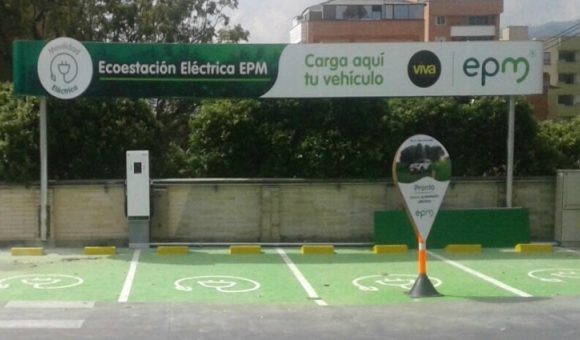Medellin to Host 15,000 Delegates for FISE Electric Power Conference

The upcoming Feria Internacional del Sector Eléctrico (FISE) conference November 25-27 at Plaza Mayor convention center in Medellin will host some 15,000 national and international delegates and some 300 exhibitors, one-quarter of which are international companies.
This sixth version of FISE – which first started in 2006 – is unique among Colombia’s power- industry conferences in that it attracts all the major players in all four sectors: generation, transmission, distribution and commercialization, as FISE director Elena Rico Villegas explained to Medellin Herald in an exclusive interview.
The 2015 version of FISE – titled “New Ways of Generating Added Value in the Power Industry” — will occupy 88% of the total pavilion space at Plaza Mayor, where numerous technical presentations will take place alongside the exhibitions and the meet-and-mingle receptions, Rico said.
Of six international presenters invited to FISE 2015, three are from North America, Rico said.
Some 55 pre-qualified international buyers are expected this year, along with 30 national buyers, with US$120 million in new business projected be generated – up from $106 million at the 2013 edition of FISE, Rico said.
FISE is the result of a collaboration between the Medellin Chamber of Commerce (CCM) for Antioquia, the Medellin city government, the Center for Research and Development of Electricity Sector Technology (CIDET), and the Electric Energy Cluster.
Medellin’s Antioquia department has for decades been the single-greatest power generation source for Colombia, mainly via massive hydroelectric projects.
A new, 2.2-gigawatt hydroelectric dam (dubbed “Hydroituango) principally owned by Medellin-based EPM is under construction and expected to start generating power in 2018. It will provide fully 13% of the entire country’s power capacity when completed in 2021/2022.
Among the 19 co-sponsors for this year’s FISE include EPM (Colombia’s biggest single power-industry player, participating in all four sectors); ISA (Colombia’s national power transmission provider); Isagen (the Colombian government’s majority-owned power generator); global power technology giants Siemens, Eaton and ABB; and numerous technology, equipment, systems-control, consulting and engineering firms.
Colombia Power Sector Growing
Compared to the situation when an El Niño drought caused a national power crisis in 1992, Colombia’s power sector – still dominated by hydroelectric generation — today has vastly improved in terms of capacity, coverage and reliability.
The 2007 version of El Niño was even worse than that of 1992, yet Colombia didn’t have a single instance of power rationing in 2007, Rico told us. The expansion of thermoelectric plants (mainly tapping natural gas and fuel-oil) as well as wind and solar power have helped ease the reliance on hydropower.
Meanwhile, Colombia’s power-delivery reliability and power-generation environmental footprint now rank among the world’s best, according to a 2014 global study by the World Energy Council (WEC).
In that study, Colombia ranked fifth in the world for energy security, fourth in the world for environmental stability and 16th in the world when including all factors including service reliability and coverage, according to WEC.
Thanks to power-sector deregulation/re-regulation, massive private and public investments in generation, transmission and distribution occurred since the power crisis of 1992.
As a result, fully 97% of Colombia’s population is now connected to the national grid.
But power still is lacking in some remote areas, which has spurred several innovative, off-grid power-generation projects, Rico explained.
In addition to presentations on several “green” and off-grid advanced technologies that could help bring power to remote areas, FISE 2015 also will include presentations on novel schemes including “smart-grid” development, electric vehicles, and home-to-grid “prosumidor” power initiatives, she said.
While some industrial consumers have complained that Colombian power tariffs are relatively expensive compared to other countries in Latin America (and elsewhere), that comparison can be flawed when considering the poor reliability of power delivery in countries including Venezuela, Brazil and Argentina, according to a recent joint study by Andeg (National Association of Generating Companies), Acolgen (Association of Colombian Electric Generators), Andesco (National Association of Public Service Companies) and Asocodis (Colombia Association of Electric Power Distributors).
In that study, Colombia’s average industrial power tariff (US$0.11/ per kilowatt-hour) ranked in the middle of countries around the world, with Italy (US$0.22 per kiloWatt-hour) the priciest, Germany the second-most expensive (U$0.205/kW-hr) and Ireland the third-most expensive (US$0.166/kW-hr).
The UK, Spain, Mexico, Portugal, Belgium, Holland, and France all have higher power costs than Colombia, that study shows.
In South America, the study found that Chile had cheaper power (US$0.089/kW-hr), as did Brazil (US$0.076/kW-hr) and Peru (US$0.07/kW-hr). But both Chile and Brazil have suffered from power-supply problems, while Peru subsidizes the cost of natural gas to its thermoelectric plants, according to the study.
Brazil recently was forced to reverse an earlier decree that had slashed power costs by 20% because of subsequent power rationing, the study noted.
Meanwhile, in a September 8 interview published in Medellin daily newspaper El Colombiano, EPM director Juan Esteban Calle was quoted as saying that with the recent decline in the value of the Colombian peso — to around COP3,200 per US$1 — Colombian industries that are on the “Level 4” high-tension power network today are paying only US$0.06/kW-hr. That’s down sharply from the US$0.09/kW-hr rate when the Colombian peso traded at COP2,000 per US$1 early last year.
















